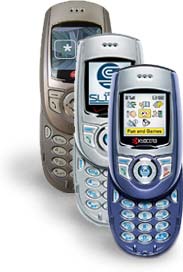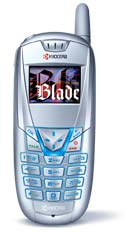|
|


TechnoFILE is copyright and a registered trademark © ® of
Pandemonium Productions.
All rights reserved.
E-mail us Here!

A Trio of Cures for Cell Phone Hangupsby Jim Bray Cellphones continue to get smaller, cheaper, and with more stuff packed into them. And people keep buying them. When will the saturation point arrive where people no longer want smaller, no longer care about games or text messaging or cameras? I have no idea. I have to admit I'm left a little confused by these phones, even as a gadget freak. My life isn't complicated enough to require a phone that does anything other than make and receive calls (voice mail's nice, though), yet I keep getting all these state of the art phones and, while they're pretty neat when it comes to the “gee whiz factor” they still don't make me want to give up my ancient (gee, it must be three years old by now!) cellphone. Still, they are definitely cool... The latest three I got to try were a pair from Kyocera, the Slider and the Blade, and Motorola's V300 camera thingy phone. All have some fascinating reasons for their target audience to love them, and I enjoyed messsing around with them – yet all had things that drove me nuts as well, though some would argue that isn't a long drive... First up was the Kyocera Slider (see photo above), which was hands down my favorite of the three. And hands down may be the operative phrase, because the way this little beastie just slides open makes it perfect for use with one hand, something I've never managed to accomplish with those little phones that flip open like a communicator from the original Star Trek TV series. This thing, as its name implies, merely slides open. You just squeeze it a little and push it open with your thumb and Presto! This gives you the advantage of a tiny phone that fits virtually anywhere, yet is easy to use one-handed. For that reason alone I really liked it. The Slider comes with a 65,000-color display and BREW 2.0 technology for downloading games and ring tones (for a price, of course). You can do two-way messaging from Enhanced Messaging Services (EMS) and the Wireless Application Protocol (WAP) browser. The company says you can use funky graphics, sounds and fonts, so if this is important to you you'll be very happy indeed. One thing I loved was its voice activation (isn't unique to the Slider, of course, but it's terrific). You can store numbers and activate them by telling the phone to call. For instance - since I don't have a large circle of friends - I programmed in my wife's work number and my home number, and all I had to do to phone them was activate the feature (which is “one button easy”) and at the verbal prompt speak “Home” or “My wife's name” (whatever it is!) and the Slider'd call. This is a wonderful feature that almost turns the phone into a hands free unit (except that you still need to hold it). The downside is that I'd get the odd strange look when I walked down the street saying “Home” into the telephone. I guess people assumed that I thought it was some kind of transporter.... The downside I found to the Slider was its volume control. This seemed to work totally at the phone's discretion, much to my chagrin. Maybe it was the location of the volume control (handily put right where my fingers would find it – whether I wanted them to or not), but I don't think so. Anyway, the volume would be either listenable (which to my rock'n'roll-ravaged ears meant “full,” especially outdoors), or too soft. Worse, I could start a call and it would be working fine, only to discover the volume dropping off during the call more rapidly than the Mariannas Trench. It was extremely frustrating and enough to make me toss the otherwise lovable Slider against the nearest wall. And that was enough to make an otherwise enjoyable experience very frustrating. Anyway other features include Speakerphone, a vibrate alert, headset jack, multiple language options, predictive text-input software for rapid text entry, TTY and TDD enabled for the hearing impaired (maybe I should have tried that one!), Scheduler, calculator, alarm clock, stopwatch and built-in contact directory. Battery life seemed fine. The Slider was easy to use, with a well laid out display and keypad. 
On the other hand, the Kyorcera Blade doesn't fold up or slide open. It's just a little phone that sits with its keypad exposed to the elements – much like my regular cellphone, but smaller than its battery. It's a handsome phone that works well. I didn't have the volume problems that I had with the Slider, either, which was a bonus. The gimmick (or at least one of them) with the Blade is its built in flashlight, which is activate by pressing one of the keys. Neat, but necessary for a phone? Well, I suppose if you're searching for enlightenment.... Most of the other features are quite similar to the Slider, without the sliding, and that's fine. For old farts like me, the phone worked very well. I thought the keypad layout was fine, but the keys are the same color as the body and that made it a bit hard to use the phone without putting on my reading glasses. This isn't just a “Blade” thing, however. There's an abundance of products that inflict such ergonomic angst on me. When the keypad's lit up this problem corrects itself, so at best it's a minor concern. The third phone was Motorola's V300 and it offered a lot of nifty features – most of which are comparable to the ones on the Kyoceras outlined above. But it also rubbed me so much the wrong way it was easily my least favorite of the three. 
Why? Keypad design, specifically. This thing looks as if the keys were shot onto the pad from a shot gun; they're sprayed apparently at random over the phone's face. So it was difficult to see which were number keys and which were otherwise designated. Okay, maybe that isn't quite fair. There does seem to be a rhyme and reason to the buttons, some of which are oval and some round, but its seems more like a case of design for design's sake rather than efficiency. And an ergonomic nightmare for those whose vision may be less than optimal for up close work. Imagine: to use this phone I'd have to either punch keys hoping for the best or stop, put on my reading glasses, and then use it. Or try using it by feel, which is a pain in the bottom. Now, if I actually owned the phone and therefore spent enough time to get used to it the problem would undoubtedly solve itself as familiarity bred contentment, but I didn't have that luxury. The V300 is a flip phone (like those Star Trek communicators mentioned above), so the keypad is hidden and protected when not in use. This is nice, but now that I've tried the Slider I prefer the way Kyocera did it because it's far easier to just slide the thing open with your thumb; flipping it open really requires two hands. Most of the features, such as voice activated dialing, are quite similar to the Kyoceras, and the ones I tried work about the same. You also get a built in scheduler, calculator, alarm clock, stopwatch and contact directory. The biggest innovation here is the inclusion of a color still camera I found quite handy for freaking out people at a dinner I was forced to attend while I was playing with the phone. You can snap a shot and save it as your phone's screen saver or wallpaper, or e-mail it to someone via the phone into which it's built. Motorola says you can even attach a voice message to a picture and fire it off to another phone or an e-mail address. I guess this is kind of neat, but I'd rather have a dedicated digital camera if I need to take pictures. That said, I can also think of terrific uses for such a feature – just not for my lifestyle. Bottom line? Each of these phones offers the same basic capabilities – except for the Motorola's camera – and are very flexible and feature-packed. My favorite was the Slider, because of the sliding feature – though the volume level problems would have prevented me from actually buying such a phone. To be fair, however, my copies of all three phones were demo units that have undoubtedly been abused by other media whores before me, so brand new units may not have the problem. But all three phones should serve their target markets well; which one's best for you depends on your lifestyle, needs, and – alas! - eyesight.
|
|
|
| Support TechnoFile via Paypal |
| TechnoFILE's
E-letter We're pleased to offer our FREE private, subscription-based private E-mail service. It's the "no brainer" way to keep informed. Our Privacy Policy |